How to Setup Youtube Advertising Campaign
Nine-step guide is simply a beginner's guide on how to start building your YouTube campaign presence.
Youtube Campaign budget cost,
Combine that audience with
Google’s AdWords targeting capabilities and it’s clear marketers have the opportunity to reach new customers locally and around the world with YouTube advertising.
The emotional power of video also allows marketers to make a more personal connection with their audience than they can with other types of paid advertising.
In fact, advertisers who ran a YouTube video campaign saw an average increase of 20% more traffic to their site, according to Google.
Let’s get started…
While video content for TrueView ads must be hosted on YouTube, the ads can appear on both YouTube and other publisher sites in the Google Display Network.
Let’s get to the various TrueView ad formats and how to best optimize each one:
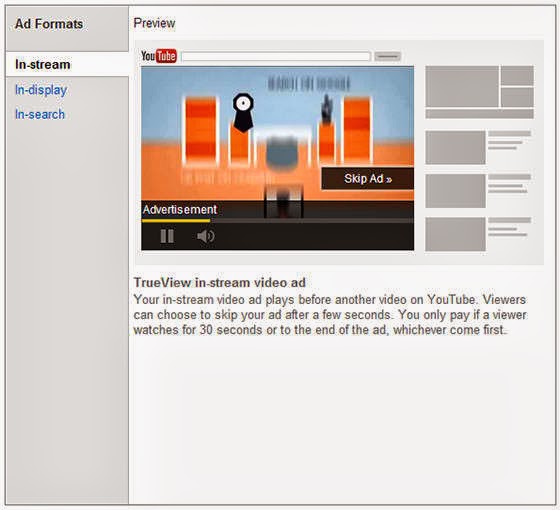
In Stream ad play like traditional TV commercials at the beginning of monetization on YouTube videos. Viewers see five seconds of your YouTube ad campaign with different ad rate value and then you can choose to keep watching or skip the rest. If they choose to watch at least 30 seconds of your ad rate it possible you pay a “cost-per-view” price.
For InStream ads, you should avoid repurposing your existing video content and create a separate ad that’s compelling right off the bat.
Here’s a fun example from Kmart called “Ship My Pants”:
Some strategies to follow with InStream ads:
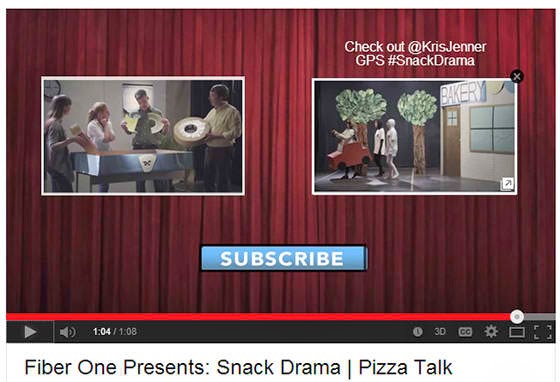
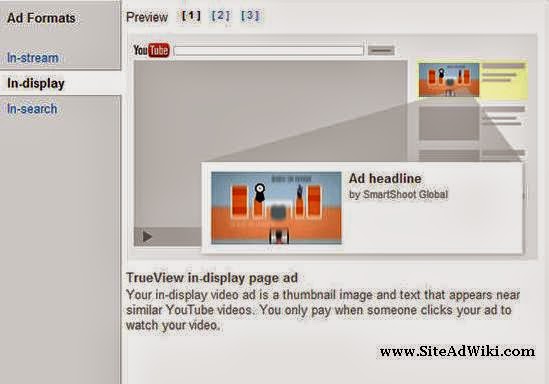
In Display ads appear as a thumbnail and text in the right-hand pane of suggested and recommended YouTube videos. You pay a “cost-per-view” when a user clicks-through your ad and begins watching your video.
Unlike InStream videos, InDisplay ads are a great place to promote your existing video content. Just make sure to follow the best practices below:

InSearch ads appear on the YouTube Search results page. Similar to InDisplay ads you pay a “cost-per-view” when a user clicks through your ad and begins watching your video.
Similar to paid search ads you have the ability to create a custom headline (25 character limit) and a custom description (35 characters per each description line).
InSearch ads look a lot like InDisplay ads, so it’s important to follow the same best practices, including a compelling thumbnail and CTAs to promote subscribes, likes, or website visits.
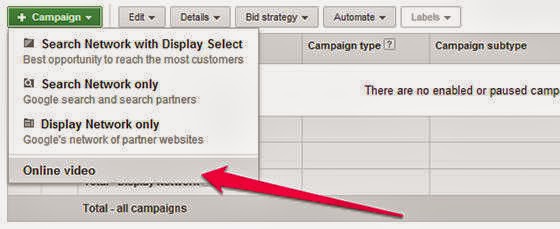

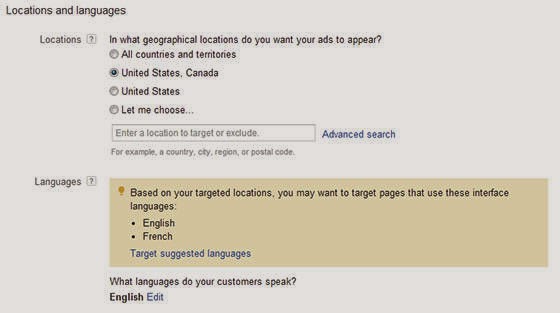
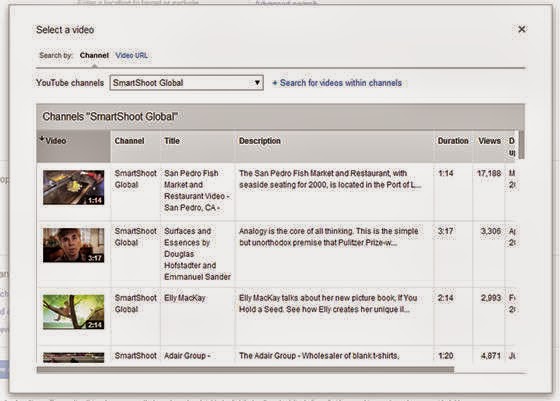
Next, choose the video ad format. Then select whether you want your video ad to show up on YouTube, Google Display Network or YouTube Search.
Note that where your video can be displayed depends on the ad format. If you select In-search, for example, YouTube search is the only available ad network.

Then, select your thumbnail and give your ad a name.
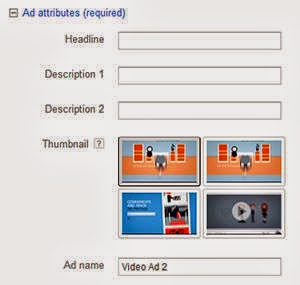
If you select In-search or In-display as the ad format, you’ll need to decide whether you want people to watch your ad on your watch page or your channel page.
Finally, select who you want to target based on gender, age, video topic, and/or keywords.


Of course, his channel is all about fitness so it makes sense for him to show some skin. The key lesson is to make sure your thumbnail begs the user to click on it.
As we’ll see below, you can target your ad by demographic or keyword, so you should know what resonates with your audience. Always test, test, test as many variations as you can.
When I did a search for “sit ups” on YouTube, I saw about 5 different ad variations for Mike Chang’s YouTube channel.
While he wasn’t shirtless in all the ads, here are a couple more variations that I saw (sorry, Mike):


ZAGG, which is best known for its line of protective coverings for mobile devices under the brand name invisibleSHIELD, creates 3-4 videos for every new product rollout. One of its most popular YouTube video clips is a demonstration of an iPhone emerging unscathed after being subjected to 1,000 pounds of weight.
As a result of its YouTube ads, ZAGG reports a 65-75% increase in conversions as well as a boost in its search traffic.
Some brands may want more subscribers and views whereas a brand like ZAGG will want you to click away and buy from their website (or, ideally, their landing page).
One simple and effective way to gain new subscribers is to just ask for it. You will find that a lot of popular video bloggers either point to the subscribe button or just come back on screen during the final seconds.
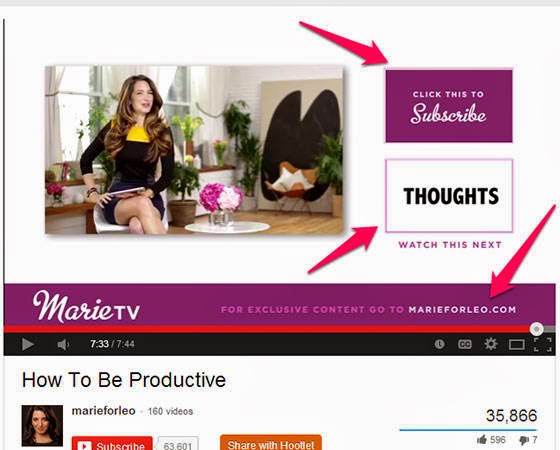
If you are ending with a link to your landing page, you’ll want to make sure the landing page flows from the video in terms of message match and design match.
For example, at the end of his video on how to drive more traffic from YouTube, SiteAdWiki more encourages viewers to sign up for a webinar on the same topic by clicking on a link in the video description.
That brings up a landing page that contains the same video and a call to action to register for the webinar (though if I were him I’d probably add my YouTube headshot to the page to further reassure visitors they’ve come to the right place).
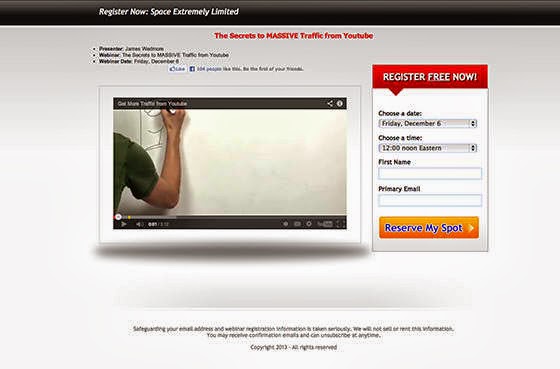
Using the tips outlined above you’ll be able to use video ads to drive targeted traffic to your YouTube channel or landing page, tapping into YouTube’s massive and highly engaged audience.
Did I miss anything? Tell me: how have you used YouTube to drive more traffic, subscribers or views?.
| |
Youtube Advertising Tutorial,
1. Create a Google AdWords Account
Your first stop is Google AdWords. If you already have an AdWords account, then go to adwords.google.com/video to create a new video ad campaign.
2. Link AdWords and YouTube
Make sure that your AdWords and YouTube accounts are linked together. You can complete this step from the navigation menu by clicking “Linked YouTube accounts”.
3. General Settings
When choosing the general settings for your ad, set up your advertising desired budget per day. It's better to start small and scale up as you get more familiar with the account and what good objectives are.
The typical budget on how much do you spend on YouTube Ads is around $.01 - $0.23. You won't pay Google unless the viewer watches your ads all the way through. There is also more customization that can be allotted for bidding for the advanced advertisers.
4. Set the Locations Where You Want Your Ad to Show Up
You can choose countries, regions, cities, ZIP codes, IP addresses, etc, going as broad or as specific as you would like. The more specific, the better qualified your viewers will be. If you're just trying to build brand awareness, then going a little more broad might be helpful.
5. Upload Your Video
Next you will select the video that you want to showcase and upload it to your account from YouTube. For more advice on how to set up ads on YouTube format your video for the best success on search engines before you upload it, see "12 Valuable Tips for Video SEO Beginners".
6. Advanced Settings
In the “advanced settings” section, you can choose what days/time of the day you want your ads to show (if there is a specific time you want to showcase your ads because a prospect is more likely to be compelled by your product), and the start and end date for your new ads.
I would suggest to shut off your ads from 12 a.m. to 6 a.m., and schedule your ads to run more during your prospects’ lunch and play hours when they are more likely to be on YouTube.
7. Device Targeting
Getting more in depth with “device targeting”, you can choose specific devices you want to target, whether it be mobile, desktop, laptop, tablets, etc. Get on the devices that you would be using to search for your product.
Are your consumers on their mobile phones? Are you advertising for a mobile app? Then go mobile.
8. Select Age, Gender, Topics & More
Here you can select age, gender, and get specific on what topics you want to show up for. The more specific you are, the better results you will get.
The more you go in depth into what categories, interests, words, websites, and phrases you want to show up for, the better targeted your audience will get. So be as specific as possible!
9. Choosing Keywords
When looking for specific keywords to target that your potential consumers will be searching for on YouTube, use the Google Keyword Tool to find relevant terms and get as specific as possible. These terms come from Google's search engine, not from YouTube, but they will still be useful in weeding out some of the keywords that could cause your ad to be viewed by the wrong person.
The longer the keyword, the more specific it is, and the more pertinent it will be to your business in capturing the right viewers.
Youtube Campaign budget cost,
Youtube Trueview Ads Average CPC Rate,
How to optimize your Youtube higher conversation advertisements,
YouTube is the undisputed #1 online video platform, attracting more than 800 million viewers per month.Combine that audience with
Google’s AdWords targeting capabilities and it’s clear marketers have the opportunity to reach new customers locally and around the world with YouTube advertising.
The emotional power of video also allows marketers to make a more personal connection with their audience than they can with other types of paid advertising.
In fact, advertisers who ran a YouTube video campaign saw an average increase of 20% more traffic to their site, according to Google.
Want to get in on that? In this post, I’ll take you through:
- The 3 types of YouTube ads
- How to create your video ads
- How to optimize your video ads (with the help of landing pages)
The 3 Types of YouTube Ads
Unlike cost-per-click (CPC) or cost-per-thousand impressions (CPM) pricing, with YouTube ads – officially known as TrueView ads – you only pay when a viewer watches your video.While video content for TrueView ads must be hosted on YouTube, the ads can appear on both YouTube and other publisher sites in the Google Display Network.
Let’s get to the various TrueView ad formats and how to best optimize each one:
1. TrueView InStream

In Stream ad play like traditional TV commercials at the beginning of monetization on YouTube videos. Viewers see five seconds of your YouTube ad campaign with different ad rate value and then you can choose to keep watching or skip the rest. If they choose to watch at least 30 seconds of your ad rate it possible you pay a “cost-per-view” price.
For InStream ads, you should avoid repurposing your existing video content and create a separate ad that’s compelling right off the bat.
Here’s a fun example from Kmart called “Ship My Pants”:
Some strategies to follow with InStream ads:
- Keep it short – the ad should be around 30 seconds and no longer than 60 seconds. From our analytics, we see a roughly 80% drop off in viewership after the 60-second mark.
- Make the first 5 seconds count – users can skip your ad after 5 seconds so you’ve got to hook them and convince them to stay.
- Include a Call to Action – tell viewers what you want them to do after watching your ad. End your video with a static call to action and give your viewers enough time to click.

2. TrueView InDisplay

In Display ads appear as a thumbnail and text in the right-hand pane of suggested and recommended YouTube videos. You pay a “cost-per-view” when a user clicks-through your ad and begins watching your video.
Unlike InStream videos, InDisplay ads are a great place to promote your existing video content. Just make sure to follow the best practices below:
- Drive viewers to more content – Use annotations to drive viewers to playlists, other videos, or a landing page.
- Create a compelling thumbnail – Upload a clear, interesting, and creative thumbnail to entice users to click your video ad.
- Use Call to Actions – make sure the video includes calls to subscribe, like, watch more content or visit your website.
3. TrueView InSearch

InSearch ads appear on the YouTube Search results page. Similar to InDisplay ads you pay a “cost-per-view” when a user clicks through your ad and begins watching your video.
Similar to paid search ads you have the ability to create a custom headline (25 character limit) and a custom description (35 characters per each description line).
InSearch ads look a lot like InDisplay ads, so it’s important to follow the same best practices, including a compelling thumbnail and CTAs to promote subscribes, likes, or website visits.
How to Create Your Video Ads
Now that you’re familiar with the different types of YouTube ads, let’s take a look at how to actually create a video ad.Step 1: Create Video Campaign in Adwords
Log-in to your AdWords account. Go to your campaigns, click on the “add new campaign” button and select “online video.”
Step 2: Set Your Budget
Give your campaign a name and then select how much you’d like to spend per day.
Step 3: Select Your Desired Location and Language
Select the countries and languages in which you’d like your video to appear.
Step 4: Select a Video and Ad Type
You can select your video through search or simply input your YouTube video URL (ie. http://www.youtube.com/watch?v=XXXXXXXXXXX)
Next, choose the video ad format. Then select whether you want your video ad to show up on YouTube, Google Display Network or YouTube Search.
Note that where your video can be displayed depends on the ad format. If you select In-search, for example, YouTube search is the only available ad network.

Step 5: Write Your Ad Copy
Enter your headline and ad text. You are limited to 25 characters for the headline and 35 characters for each description.Then, select your thumbnail and give your ad a name.

If you select In-search or In-display as the ad format, you’ll need to decide whether you want people to watch your ad on your watch page or your channel page.
Step 6: Select Targeting
Determine the maximum cost per view that you’re willing to pay. Google will show your predicted views per day based on what you enter.Finally, select who you want to target based on gender, age, video topic, and/or keywords.
How to Optimize Your Video Ads
We’ve arrived at the part you’ve been waiting for! Here’s how to optimize your video ads for maximum conversion.1. Optimize Your Thumbnail
When optimizing your video thumbnail for the highest CTR, all you have to do is take your shirt off. At least that’s the strategy Mike Chang uses when promoting his fitness videos. Given that he has more than 2 million subscribers and 276 million views, I’m not going to dispute him.
Of course, his channel is all about fitness so it makes sense for him to show some skin. The key lesson is to make sure your thumbnail begs the user to click on it.
As we’ll see below, you can target your ad by demographic or keyword, so you should know what resonates with your audience. Always test, test, test as many variations as you can.
When I did a search for “sit ups” on YouTube, I saw about 5 different ad variations for Mike Chang’s YouTube channel.
While he wasn’t shirtless in all the ads, here are a couple more variations that I saw (sorry, Mike):


2. Create Compelling Product Demonstrations
One of the best ways to leverage YouTube is to show off your product’s features and benefits.ZAGG, which is best known for its line of protective coverings for mobile devices under the brand name invisibleSHIELD, creates 3-4 videos for every new product rollout. One of its most popular YouTube video clips is a demonstration of an iPhone emerging unscathed after being subjected to 1,000 pounds of weight.
As a result of its YouTube ads, ZAGG reports a 65-75% increase in conversions as well as a boost in its search traffic.
3. End the Right Way
You always want to end your videos with a simple and easy call to action. Google would love for the viewer to stay on YouTube, so they suggest you make it easy for them to watch more videos or subscribe to your channel. But the right call to action for you depends on your goals.Some brands may want more subscribers and views whereas a brand like ZAGG will want you to click away and buy from their website (or, ideally, their landing page).
One simple and effective way to gain new subscribers is to just ask for it. You will find that a lot of popular video bloggers either point to the subscribe button or just come back on screen during the final seconds.

If you are ending with a link to your landing page, you’ll want to make sure the landing page flows from the video in terms of message match and design match.
For example, at the end of his video on how to drive more traffic from YouTube, SiteAdWiki more encourages viewers to sign up for a webinar on the same topic by clicking on a link in the video description.
That brings up a landing page that contains the same video and a call to action to register for the webinar (though if I were him I’d probably add my YouTube headshot to the page to further reassure visitors they’ve come to the right place).

Using the tips outlined above you’ll be able to use video ads to drive targeted traffic to your YouTube channel or landing page, tapping into YouTube’s massive and highly engaged audience.
Did I miss anything? Tell me: how have you used YouTube to drive more traffic, subscribers or views?.
How to Setup Youtube Advertising Campaign
 Reviewed by Fiona Queen Galvez
on
8:31:00 PM
Rating:
Reviewed by Fiona Queen Galvez
on
8:31:00 PM
Rating:
 Reviewed by Fiona Queen Galvez
on
8:31:00 PM
Rating:
Reviewed by Fiona Queen Galvez
on
8:31:00 PM
Rating:
YouTube advertisements will give you the return on investment which is a lot higher.You could build your business immensely quickly and successfully with you-tube adverts. Youtube Advertising
ReplyDeletehttps://www.l2ndm.com/advertising-on-youtube/